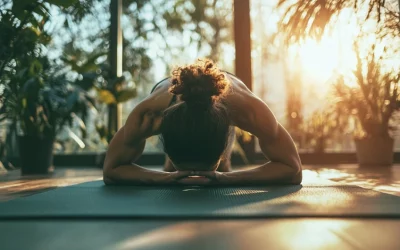You have decided to start stretching. You’ve put on the stretchy clothes, and you have the pamphlet of stretches that your physiotherapist gave you…. But now you’re wondering how long you should hold each stretch for.
Listen to your body and hold the stretch for what feels good.
Stretch length times will vary both on your purpose for stretching, such as increasing flexibility or muscle activation, as well as your stretching conditions. Regardless of stretching length, though, you should begin to see increases in your range of motion after each session.
Different stretch hold times.
Short hold times and active/ dynamic stretching is great for activating your muscles, getting your blood flowing and your body warmed up. These stretches are typically held for only about 1-3 seconds. Activation stretches are great before exercise or when you need an energy pick-up during the day.
Medium hold times are great for maintaining and improving your body’s overall mobility. Ranging from about 3-10 seconds each, these stretches allow your muscles to lengthen and relax. These stretches are more effective after your muscles have been warmed up, either through previous physical activity or from a hot bath.
Long static stretches typically range from 7-30+ seconds and are great tools for improving your flexibility. Warm up your muscles beforehand and listen carefully to your body, as it is possible to hold a stretch for too long. Longer-held stretches shouldn’t be done before a strenuous activity since they stretch and relax your muscles, which causes a temporary loss of strength and power.
While some people benefit from 60-second holds, WeStretch stops at 30 seconds to prevent possible injury. You won’t immediately see long holds in your routines, since to reduce the risk of injury, WeStretch increases the intensity very gradually. This is why your first few stretching routines may seem too easy.
Conditions that can affect how long you can hold a stretch.
When stretching, be mindful of these different elements. While you might want to quickly improve your flexibility, if you push beyond your limits, you may injure yourself or cause damage to your muscles.
How warmed up you are.
Walking inside from sitting in your car at -30C to immediately begin strenuously stretching may not be a good idea. However, stretching after a soccer game or after a warm bath will give you great results. Just be careful to not overheat!
Your age.
As you get older, you gradually begin to lose your flexibility and mobility. You can regain most of it, but you shouldn’t immediately begin to stretch like your 7-year-old self, since your body doesn’t move the way it used to.
Your current flexibility levels.
If you regularly exercise or do yoga, you might be able to start with more advanced stretches, but if getting up off the bed or picking something off the floor is a struggle, start with shorter stretches that will be easier on your body.
Hydration levels.
A large portion of our bodies is made of water. If we get dehydrated, we cannot function as well as we should be able to. This is especially true for your muscles, as they require water to help them stay lubricated and move smoothly.
Current amount of muscle fatigue.
While it is important to thoroughly stretch after strenuous exercise, listen carefully to your body. Stretching is essential to helping your muscles recover, but if your body is too worn out, there is a greater chance of accidentally overstretching or pulling a muscle.
Having a build-up of scar tissue or other medical conditions.
Scar tissue is often created as part of the healing process after you are injured. Scar tissue can begin to limit your mobility and the length of time that you are able to stretch. Similarly, medical conditions, such as cerebral palsy, can affect overall muscle tone and strength.
Regardless of your starting place, you can often increase the amount of time that you can hold a stretch for by addressing the conditions mentioned above. However, never strive to hold a stretch longer, simply because someone else is. Everyone’s body is designed differently and what works for them may cause injury to you.
What happens if you stretch for too long?
Holding a stretch for too long can actually hurt you more than it helps! While you should feel a good pull when stretching, if it begins to hurt either while in the pose or coming out of it, you’ve held it for too long or pushed too far. This is a phenomenon known as overstretching.
Overstretching is when you stretch your muscles and/or joints beyond their limits, which can cause them to become lax instead of toned and can create instability issues. Be mindful of your body when stretching and notice any subtle signs it might be telling you that you are pushing too far, such as your muscles beginning to shake.
A great example of overstretching is when someone falls into the splits in the movies. While it might be overplayed in film for dramatic effect, your muscles will likely become painful to move around afterward. Your muscles had to extend beyond what they were capable of, which can cause tearing, stiffness, and other injuries.
If you believe that you accidentally overstretched, there are a few things you can do to recover and prevent further injury.
The first thing is to stop stretching immediately and rest. Hydrate and nourish your body with a variety of healthy foods, to regain energy and start the healing process. Ice any joint or muscle that feels swollen or inflamed and sleeps as much as you can. Notice how it feels and see a trusted healthcare professional if it doesn’t get better or it gets worse.
Why do your muscles shake?
So, apart from stretching for too long or intensely, there are a few other things that can cause your muscles to shake. Please note that this information is not a substitute for medical information and to speak to your doctor if you have any concerns.
Your blood sugar levels could be dropping, or you don’t have enough electrolytes.
Electrolytes help to regulate your body’s functions and your glucose levels are what provides energy to your cells. If you are in a long stretching or workout session, an electrolyte drink isn’t a bad idea, however, for shorter sessions consider a snack like a glass of water and a banana.
Too much caffeine in your system.
Caffeine is a stimulant, which can wake your body up and cause jitters, including muscle spasms. Try reducing your daily caffeine intake and noticing the difference.
Muscle fatigue.
This is usually from pushing your muscles beyond their limits.
Simply speaking, your brain fires motor units to your muscles to activate, but the longer that those motor units are firing, the weaker and slower they become. This causes your muscles to alternate between contraction (when these units have been fired) and relaxation (when there are no units fired). A bit of shaking isn’t bad, since it reveals how hard your body is working, but fatiguing your muscles to stillness can possibly cause injury.
Reducing and preventing muscle shaking.
Many of these concerns can be addressed by awareness and taking care of your health. Be sure to eat a balanced diet, stay adequately hydrated, and regularly rest to allow yourself to recover. Increase your workout intensity gradually to reduce the risk of injuries and always pay attention to how your body feels during exercise.
While stretching, make sure your muscles are warm and start off with shorter hold times. Holding a stretch for five seconds, repeated three times with a small break in between, is as effective as a fifteen-second hold, but it reduces the risk of injury, especially for those first starting out.
Ultimately, how long you should hold a stretch for depends on your body and what feels right for you. Our recommendation is to start off with shorter hold times and gradually increase to what feels best for you!
Looking for guidance with different types of stretches and how long to hold them for? Download the WeStretch app for free from the App Store, Google Play, or use it in your desktop browser!
Any links included are for reference, additional information, or entertainment value only, without monetary compensation. Contact us on social media or at [email protected].
This article is not intended to act as or replace medical advice. Please talk to your healthcare practitioner if you have any concerns.
Written by Kayla Willsey
Updated October 15, 2021






